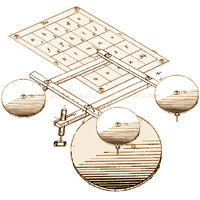In 1853, just as Isaac Pease was developing his "Spiritual Telegraph Dials" and Dr. Robert Hare was experimenting with them, a German professor of music and composer named Adolphus Theodore Wagner began experimenting with the table-tipping and rapping phenomena that was sweeping through Europe in a surge of popularity. The inventive composer devised-and then filed-London patent No. 173, for his "Psychograph" or, as he more imaginatively coined it, his "Apparatus for Indicating Person's Thoughts by the Agency of Nervous Electricty." This first-of-its-kind patent for a planchette-like device came hard on the heels of the planchette's discovery in France. The drawing provided by us here is a facsimile produced from exact period descriptions of the device, and constructed of parts of patent design engravings from the same era. These descriptions are absent from the original patent, but thankfully a retired German First Lieutenant by the name of A. von Forstner published a detailed account of the device's workings in 1854, as well as a minute description of a copy of Wagner's device provided by the professor. He was well-trained to handle recording of the proceedings, as he had already authored "The Phenomena of Table-Turning and Table-Rapping in Addition to the Explanations" in his native Berlin.
The pair, along with Herr. Baron von Eberstein and a gathered retinue of some 15 invited sitters, most of whom were dignitaries and high-ranking German officers, experimented with the device on one evening, with results described by Eberstein as follows:
The operation of the psychograph is quite simple in that hands are placed on those plates, quite lightly touching them. Very soon (in just a few seconds) the instrument comes into motion, and the pointer yields answers to questions just like those that have been asked in table-rapping; if the motion is already in process, then the letters are pointed to with a speed that matches the speed with which a typesetter sets type ; it is almost necessary that one of those present call out the letters pointed to aloud, while another writes them down, because it is hardly possible to recognize the words that are formed. Whether the participating persons on the plate see or not, whether they have their eyes open or closed, makes no difference.
The group conducted several sessions, some lasting over two hours, and recorded responses to their inquiries both comical and serious, including intricate poetry. We are fortunate to have such a detailed account that survived, allowing us to reconstruct this instrument for the very first time.






